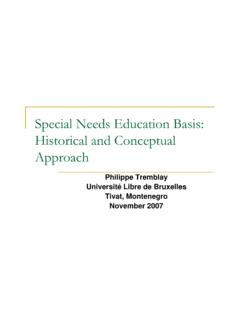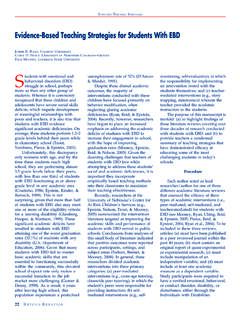Transcription of Teaching Students with Emotional Disturbances: 8 Tips for ...
1 Students with Emotional disturbances : 8 Tips forTeachersListenHelp with Listen FeatureBy Lisa K pperNational Dissemination for Children with disabilities (NICHCY) Do you have a student with an Emotional disturbance in your class this year?Or perhaps you have a student whose behavior or demeanor makes you wonder ifan Emotional disturbance is going undiagnosed? If so, please read know that Emotional disturbance can be a sensitive subject. Emotional problemsare painf ul to all concerned. Still, you can make a powerf ul dif f erence in thisstudent s lif e, especially armed with insight, instructional strategies that work, andready links to the experts that this blog will give to topQuick Facts FirstThere s a lot to know (and un-know) about Emotional disturbances , so we thought we d start with a f ew, quick,grounding f disturbance is an umbrella term that s used under IDEA to describe a wide range of dif f erentdisorders and conditions.
2 Anxiety disorders , conduct disorders , eating disorders , mood disorders , all are considered Emotional disturbances . Yet each varies f rom the other in important disturbances carry with them a stigma, despite being surprisingly common in both children andadults. (1) Most of us know someone who s depressed, lives with chronic anxiety, experiences inexplicablepanic attacks, or compulsively washes his or her hands or must do things in a particular order. Some of us arethose wide range of help is available f or children with mental health issues, both through the public schools andf rom private sources, through medication and through therapy.
3 It s crucial to connect children with that help andto conf ront the stigma and f ear that are of ten associated with Emotional and behavior dif f are of ten among the first to suspect that a student may have an undiagnosed emotionaldisturbance. (2) They may notice a student s ongoing problems with interpersonal relationships, f or example,or signs of unreasonable anger, an eating disorder, or self -injurious behavior. It s also not uncommon f orteachers to ref er such Students f or evaluation, to see that they are connected with the systems of supportsand services that can be genuinely helpf ul, even lif nation s special education law, the Individuals with disabilities Education Act (IDEA), provides a definitionof Emotional disturbance that guides how schools identif y (and help) Students with Emotional disorders .
4 In2011, more than 371,000 Students (ages 6 to 21) received special education and related services in our publicschools under the category of Emotional disturbance. (3) Emotional disturbances can af f ect many dif f erent aspects central to student learning, including (but notlimited to): concentration, stamina, handling time pressures and multiple tasks, interacting with others,responding to f eedback, responding to change, and remaining calm under stress. (4) Many of the medicationsprescribed to address the disturbance also have side ef f ects that can impact student to topTips for TeachersGiven how common mental health disorders actually are, it s likely that you may have a student or two with anemotional disturbance in your classroom.
5 How do you best help them, support their learning, and encouragetheir well-being? Consider these tips and strategies, and consult with the experts as you need to, includingthose in your school, district, and | Learn more about the student s specific mental health disturbance. A mood disorder such asdepression will af f ect a student s demeanor, thinking, learning, and behavior dif f erently than an eating disorderlike anorexia or bulimia. Knowing how the particular Emotional disturbance manif ests itself and is managed canhelp you support the student s education in individualized, inf ormed, and ef f ective ways.
6 Consult theorganizations we ve listed in our Emotional Disturbance f act sheet f or expert guidance about specif icemotional | Learn more about the student s strengths, too. The student brings much more than an emotionaldisturbance to class. What about his or her strengths, skills, talents, and personal interests? All of these aretools in your hands as you adapt instruction, give out assignments, ask the student to demonstrate learning,and create opportunities f or | Remember, they re kids first. By and large, Students with Emotional disturbances aren t scary, dangerous,or time bombs waiting to go of f.
7 They are themselves, in need of your skill and support, and quite capable oflearning. Do not permit bullying, teasing, demeaning, or exclusion of the student by other Students or by | Support the student s inclusion. Emotional disturbances , by their very nature, can make it dif f icult f orpeople to build or maintain satisf actory interpersonal relationships. You can support the student with anemotional disturbance in subtle but meaningf ul ways, especially during group work, cooperative learningactivities, peer interactions, and team projects. There may also be times to let the student work alone, take abreak, or have a hall pass f or some quiet time | Set clear behavioral rules and expectations for the entire class.
8 Students with Emotional disturbancesare f requently the targets (rather than the initiators) of other Students misbehaviors. Having a stated, explicitclassroom management plan provides a solid structure by which both teacher and Students can addressinappropriate behavior, understand consequences, and develop a shared approach to behavior in class andtoward one another. This IRIS training module may help you set up such a | Provide accommodations. The student s individualized education program (IEP) will spell out whataccommodations the student is to receive in class and during testing.
9 If you re not part of the team thatdevelops the student s IEP, ask f or a copy of this important document. Also check with your school district f orguidance on local policy and appropriate classroom accommodations f or Students with Emotional accommodations will vary depending on the nature of the student s Emotional disturbance, of ten theappropriate accommodations will address:side ef f ects of medicationbehavioral unpredictabilityimpairments in concentration and memory7 | Join the student s IEP team and help shape his or her special education program. As a team member,you can make sure the IEP includes accommodations and classroom adaptations appropriate to the student sneeds and success in your class.
10 You can also advocate f or program modif ications and supports f or yourself,to help you support this student in | Communicate with the student s parents. Parents are a great source of inf ormation about their ownchildren. As members of the IEP team they are likely to have a multitude of suggestions f or what would benef ittheir child with an Emotional disturbance in school. They can also keep you inf ormed as to events anddevelopments in the child s lif e, new medications or treatments, and how these might af f ect the student to topIn ClosingEmotional disturbance in children is very disturbing, it s true.








